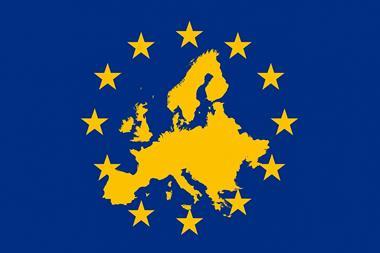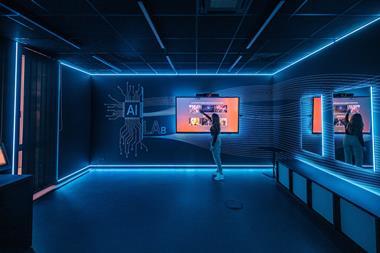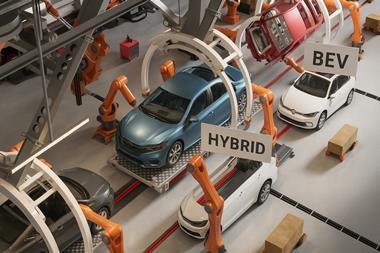Having the right tool for the job is a process being made easier thanks to advances in rapid manufacturing, and it is bringing big benefits to every part of the manufacturing process
At the first mention of prototyping in this 3D-enlightened age, the immediate association is rapid prototyping (RP), or ‘additive fabrication’ to use its modern description - plastic (and sometimes metal) parts produced directly from CAD models without machine tools.
Whilst RP techniques produce physical models relatively quickly, they are little more than 3D hard copies in the main, suitable for ‘form, fit and function’ studies. In terms of the engineering prototyping phase of product development they are usually only a first step in the process rather than the process itself.
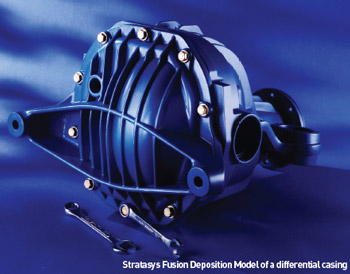 Today there is much more interest in rapid manufacturing (RM) but this interest is mixed: there are those who are excited by the benefits it brings to the early adopters; those who reserve judgement until the current technological limitations are resolved; and those interested at a basic level but are waiting until it becomes more mainstream before they investigate further.
Today there is much more interest in rapid manufacturing (RM) but this interest is mixed: there are those who are excited by the benefits it brings to the early adopters; those who reserve judgement until the current technological limitations are resolved; and those interested at a basic level but are waiting until it becomes more mainstream before they investigate further.
What has been identified already is that there are tremendous time and cost savings produced by RM that go well beyond the direct savings realised by just eliminating tooling. Rapid manufacturing impacts nearly every discipline in a manufacturing environment, from production planning to inventory control, and each of these disciplines can bring big benefits.
One such benefit is being exploited by BMW in its Regensburg plant. Here the company is using Fused Deposition Modelling (FDM) – a process from Stratasys that builds parts by extruding a semi-molten filament through a heated nozzle in a prescribed pattern onto a platform. The plant’s jigs and fixtures department uses FDM for the direct production of tools for manufacturing and testing. “BMW has determined that the FDM process can be an alternative to the conventional metal-cutting manufacturing methods like milling, turning, and boring,” says engineer Günter Schmid. He and fellow engineer, Ulrich Eidenschink, have shown financial advantages, including cost reductions in engineering documentation, warehousing, and manufacturing.
BMW engineers have discovered that, for hand-held devices used on the assembly line, there are even greater advantages that arise from the design freedom that the FDM technology offers.
Capitalising on the elimination of constraints, Schmid and Eidenschink employ FDM to make ergonomically designed assembly aids that perform better than conventionally made tools.
Worker comfort, ease-of-use, and process repeatability improves individual productivity. To facilitate these criteria, the plant uses FDM to enhance the ergonomics of its hand-held assembly devices. The freedom of design allows engineers to create configurations that improve handling, reduce weight, and improve balance. “The tool designs we create often cannot be matched with machined or moulded parts,” says Schmid.
In one example, BMW reduced the weight of a device by 72 per cent with a sparse fill build technique. Replacing the solid core with internal ribs resulted in a cut of 1.3kg from the device.
“This may not seem like much, but when a worker uses the tool hundreds of times in a shift it makes a big difference,” he continues.
Another advantage of rapid manufacturing is improved functionality. Since the additive fabrication process can easily produce organic shapes that sweep and flow, the tool designers can maximise performance while improving ergonomic and handling characteristics. “The layered FDM manufacturing process is well suited for the production of complex bodies that, when using conventional metalcutting processes, would be very difficult and costly to produce,” says Eidenschink. An example is a tool created for attaching bumper supports, which features a convoluted tube that bends around obstructions and places fixturing magnets exactly where needed.
The criteria for viable FDM tools are temperature, chemical exposure, precision and mechanical load. With FDM’s ABS material, which is similar to polyamide, many tools for vehicle assembly satisfy these criteria. Both Schmid and Eidenschink believe that no enterprise can afford to do without rapid prototyping for product development, yet they see so many possibilities in RM.
“FDM is taking on increasing importance as an alternative manufacturing method for components made in small numbers,” says Schmid.
Another iconic FDM user is Ducati, the racing motorcycle maker that popularised the Desmodromic Valve Actuation System – no valve springs just a cam for opening and a cam for closing the valves. Ducati’s unique engines, innovative design and advanced engineering has seen it collect a string of World Superbike Championships and it offers some of the most sophisticated bikes on the road.
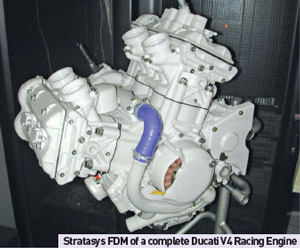 One of its key challenges is to reduce time-to-market for new products by reducing the design cycle. To help meet this challenge the entire design process at Ducati is validated using FDM rapid prototyping systems from Stratasys. FDM enables Ducati to build both concept models and functional prototypes from ABS, polycarbonate and polyphenylsulfone.
One of its key challenges is to reduce time-to-market for new products by reducing the design cycle. To help meet this challenge the entire design process at Ducati is validated using FDM rapid prototyping systems from Stratasys. FDM enables Ducati to build both concept models and functional prototypes from ABS, polycarbonate and polyphenylsulfone.
By bringing FDM in-house, the company cut 20 months from the development process of the engine designed for its Desmosedici race bike. The exotic sounding Desmosedici engine (it simply means 16-valve in Italian) was designed and assembled in only eight months. The company’s previous engine had taken 28 months to design and build, when the majority of prototypes were outsourced to service bureaus.
Ducati wanted the Desmosedici to surpass its predecessor by providing the additional power necessary to continue its success in the MotoGP race series. Using two FDM rapid prototyping systems (the FDM Vantage and FDM Titan), the design team built a prototype engine composed entirely of polycarbonate components.
“The accuracy and durability of the models enabled us to physically analyse each component, recognise design flaws, and rectify them quickly,” says Piero Giusti, R&D CAD Manager for Ducati Motor Holding. “The FDM prototype engine gave us a more holistic view of the engine design than we’ve had with previous engines. It decreased the number of errors in the design and significantly sped up the development process.
“Having the polycarbonate prototype engine helped confirm that the design was the right. Our design team was able to quickly eliminate any technical concerns.
More importantly, it was able to present the whole engine prototype to the organisation and gain buy-in for its vision of the double twin-cylinder design.
“Prior to purchasing these systems, our service-bureau expenses totalled approximately €1m ($1.3m) per year.
This is much higher than the cost of purchase, maintenance, and materials for the two FDM machines. Not only can we produce higher quantities of parts at a fraction of the cost, but we are also able to forecast costs for each project much more accurately.
“To keep Ducati at the forefront of engine design, we sought a technology that could make accurate, durable prototypes quickly,” says Giusti. “FDM was the only solution that could meet our requirements. The machines were as easy to install as a printer and they now constitute an integral part of our design and manufacturing process.”
Korean-based Hyundai Mobis, another FDM user, makes original and aftermarket equipment for the automotive industry, including Hyundai and Kia. In its drive to be best-in-class and a global top ten supplier, it depends on RP for design verification, airflow evaluation, and functional testing. The company uses FDM for components such as instrument panels, air ducts, gear-frame bodies, front-end modules, and stabilizer-bar assemblies.
Consumers judge the quality of a vehicle on many factors, but few are as important as component fit and finish.
Using rapid prototypes, Hyundai Mobis evaluates the smallest details to ensure the fit conveys a sense of quality.
The design verification of an instrument panel for Kia’s Spectra shows this commitment to detail. The instrument panel exceeded the large build area of the company’s RP system, a Stratasys FDM Maxum, so it was modelled in four pieces and assembled to measure 498x454 x1,382mm.
Before installing the instrument panel model in a cockpit assembly, the design team mounted it on a fixture and scrutinized it with a coordinate measuring machine, and captured hundreds of measurements. According to Tae Sun Byun, Principal Research Engineer for the Hyundai Mobis Auto-Tech division: “Dimensional accuracy and dimensional stability were critical for the design verification. The FDM Maxum, with its ABS plastic, gave us both. Over a length of 1,382mm, the greatest deviation was just 0.75mm.”
Mounted in the cockpit mock-up, the instrument panel revealed 27 design flaws. Although all were minor, collectively the errors would have added cost and delayed the project. “The rapid prototype allowed us to find design issues that were challenging to see in 3D CAD,” says Byun. “When the FDM part was combined with mating components and subassemblies, the design flaws were quickly detected and repaired.”
As a result of this attention to detail, Kia has garnered accolades from Car and Driver magazine, which wrote of the Spectra “…its interior fit and finish is premium.”
In addition to the tight modelling tolerance of the FDM Maxum, Hyundai Mobis also values its other advantages. “It gives us the durable parts we need for assembly and functional testing,” says Byun. “And it’s easy to use. The water-soluble support structure is very important due to our time pressures. Without this, a complex component like the instrument panel would take us many hours, if not days, just to post-process.”
The other popular technology is Selective Laser Sintering (SLS) from 3D Systems Corporation. They have recently installed a 3D Systems’ Sinterstation Pro SLS system at the Advanced Digital Manufacturing (ADM) Centre at Renault F1 HQ in Enstone, England. This is the first of these new systems to be installed in Europe. The Renault’s F1 ADM Centre supports all aspects of its Formula 1 design: wind tunnel, full-scale application and production moulds, patterns and parts for the Renault F1 Team car. In addition to the newly commissioned Sinterstation Pro system, the ADM Centre operates five SLA 7000 systems.
“Rapid direct manufacturing plays a significant role in the development and manufacturing of our racing cars,” said John Mardle, Renault F1 Team Operations Director.
“Because the Sinterstation Pro SLS system was designed as a true manufacturing system, it is an ideal addition to our ADM Centre. With substantially greater build capacity, tighter closed-loop controls and automated materials delivery, as well as tracking available on the new system, we expect to produce larger parts, components and patterns even faster than we do now, and to manufacture more and more on-car, ready-for-race parts directly from the Sinterstation Pro.”
“We know that there is a direct correlation between how many parts we test in the wind tunnel and the level of competitiveness we reach on the track,” said Bob Bell, Technical Director for Renault F1 Team. “In 2004, we tested 13,000 stereolithography wind tunnel car components. In addition to this, we use QuickCast patterns to manufacture our titanium investment castings.”
“When we introduced SLS technology in our Advanced Digital Manufacturing Centre last year, we found that it gave us the ability to produce specific car components in tenths of the time it used to take with traditional injection moulds, and all our on-car rubber components are now manufactured using LaserForm A6 tools. The addition of the new Sinterstation Pro will enable us to increase our production speeds and expand our SLS part utilisation, realising significant time and cost savings,” concluded Bell.
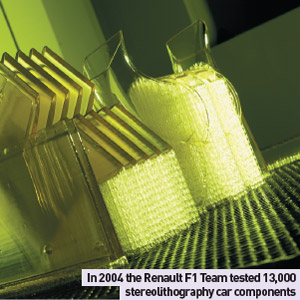 The ‘hot’ technology of the moment in SLS comes from CRP Technology of Modena, Italy. CRP has produced a revolutionary SLS material called Windform XT, the XT stands for ExTreme, which is representative of its performance. CRP is a global leader in the production of composite materials for RP and RM and a partner of several international racing teams in MotoGP and Formula 1.
The ‘hot’ technology of the moment in SLS comes from CRP Technology of Modena, Italy. CRP has produced a revolutionary SLS material called Windform XT, the XT stands for ExTreme, which is representative of its performance. CRP is a global leader in the production of composite materials for RP and RM and a partner of several international racing teams in MotoGP and Formula 1.
The Windform series of materials are all composite polyamide based powders. They have already been widely used for wind tunnel models and production parts for racing cars and motorbikes, as well as specialist road vehicles.
All of these materials offer competitive advantages in terms of high performance and prototype definition, including: 100 per cent guaranteed functionality to effect all necessary and useful tests for final use; extreme reliability and resistance for adaptation testing; aesthetic verification and immediate ergonomics; and the speed of execution, fundamental for highlighting project errors.
The powdered material has been shown to have good recyclability so the true cost of components is lower than might be expected, which is leading to Windform XT being used for less exotic applications where a combination of accuracy and excellent material properties is required.
Windform XT is based on a carbon-filled polyamide and produces black parts with a smooth finish and a sparkling appearance.
When used for wind tunnel models, Windform XT offers excellent detail definition, stiffness, and resistance to vibration, and can be used to create thin parts with high strength. In addition, the black colour assists visibility in wind tunnel testing.
Many F1 parts are now produced in Windform XT, such as brake ducts, air intakes, cooling ducts and bodywork flaps. Bike parts include the chain pad, head cover, waterpump cover, seat, mudguards, windscreens and airbox. Several bodywork components on the Lamborghini Gallardo road car are also manufactured from Windform XT.
Where the racing industry goes we all follow eventually, especially when the technology involves reduced cost and weight. Rapid prototyping as a technology has matured well since its inception by 3D Systems in 1986 – rapid manufacturing is just coming on stream and it is beginning to demonstrate significant advantages in all manufacturing departments.

































